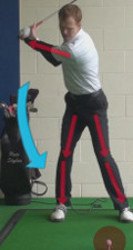
Downswing
The downswing is a crucial phase in the golf swing where the golfer transitions from the backswing to the impact position. It is the motion of bringing the golf club back down towards the ball with the intention of generating power and accuracy.
During the downswing, various body parts and movements play a significant role in achieving an effective shot. Here are some key elements to consider:
- Weight transfer: As the downswing begins, the golfer shifts their weight from the back foot (right foot for right-handed players) to the front foot (left foot for right-handed players). This transfer of weight helps create a stable base and generates power.
- Hip rotation: The hips are the driving force behind a powerful downswing. As the weight shifts, the golfer initiates the rotation of the hips towards the target. This rotation helps transfer energy from the lower body to the upper body and ultimately to the club.
- Club position and path: The club must be brought down on the correct path to ensure solid contact with the ball. Ideally, the club should follow a shallow, inside path during the early stages of the downswing, gradually transitioning to a more vertical plane as it approaches the impact area.
- Downswing sequence: The downswing should ideally begin with the lower body (hips), followed by the torso and arms. This sequence allows for a smooth transition of power from the lower body through to the clubhead. It is crucial to avoid any abrupt or jerky movements that may result in inconsistent shots.
- Wrist hinge: As the downswing progresses, the wrists gradually unhinge, allowing the clubhead to lag behind the hands. This lagging motion creates a whipping effect, adding speed and power to the clubhead just before impact.
- Impact position: The downswing culminates in the impact position, where the clubface strikes the ball. The ideal impact position includes a square clubface, a descending strike on the ball, and a body position that is balanced and aligned towards the target.
A well-executed downswing is crucial for generating power, accuracy, and consistency in golf shots. It requires a combination of proper body movements, sequencing, and club position. Practice and repetition are key to developing a repeatable and effective downswing.
Remember to stay relaxed and maintain a smooth tempo throughout the downswing. Tension or rushing can lead to poor results. It is also beneficial to work with a qualified golf instructor who can provide personalized guidance and feedback on your downswing mechanics.
By mastering the downswing, you will be on your way to hitting solid shots with increased distance and accuracy. Practice regularly, focus on the key elements mentioned, and enjoy the rewards of a well-executed downswing in your golf game!





